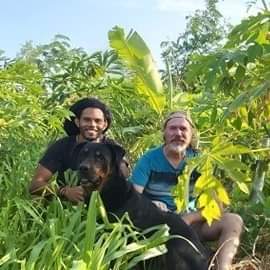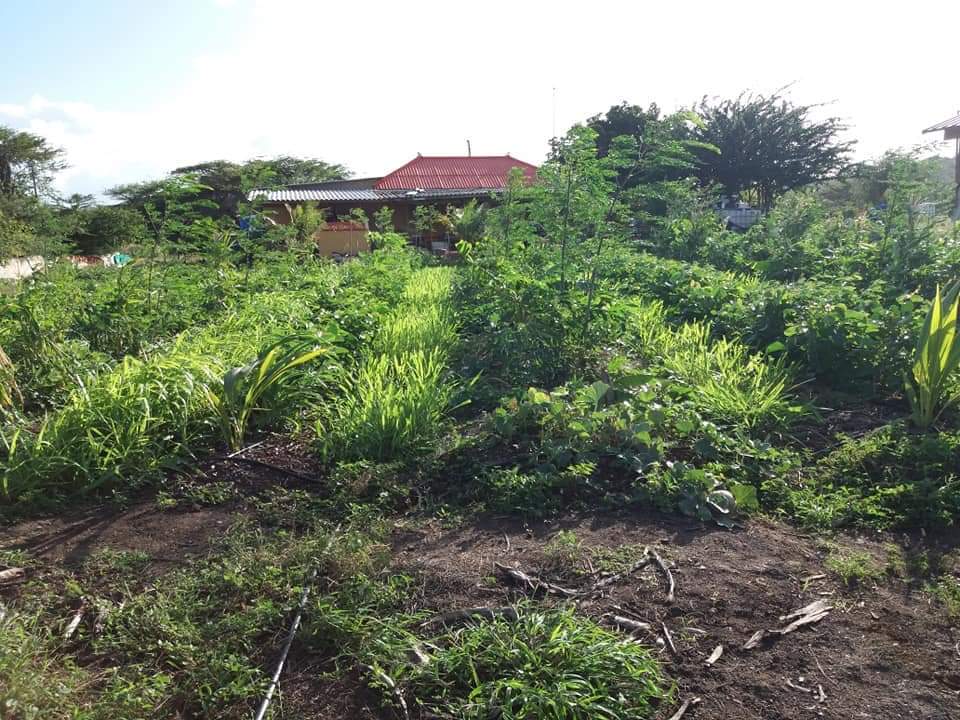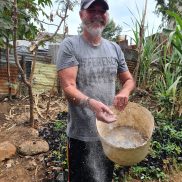Water Conservation Measures: The Role of Mombasa Grass in a Syntropic System
In my first article, I described how a course on syntropic agroforestry in Curaçao changed the direction of farming on that small but gorgeous island.
In this article, I want to explain which measures we took that made it possible to reduce the irrigation rate in the dry season of a semi-arid climate zone from 4-liter water per square meter once a day to that same amount once every 3 weeks.
Before I start, I wish to quote my excellent teacher, Thiago Gimenez Barbosa, who told us that “most people think that to be able to grow plants, you need water, but to the contrary, we say that to have water, you need plants”.
This shocking revelation was entirely new to us, but more claims point in that direction. The godfather of natural farming, Masanobu Fukuoka, said, “It was in an American desert that I suddenly realized that rain does not fall from the heavens – it comes up from the ground. Desert formation is not due to the absence of rain, but the rain ceases to fall because the vegetation has disappeared.’
Vegetation is of extreme importance when it comes to water. So we focused on that.
During the implementation of our test syntropic agroforestry farm, the focus was on planting a lot of biomass. Biomass in the shape of Mombasa grass on every bed/field next to another. At the same time, every third bed was solemnly reserved for planting fast-growing trees (producing large amounts of biomass).
The function of Mombasa grass and its importance as a measure for “planting water”
As the name suggests, Mombasa grass is indigenous to that specific region in Africa. The scientific name of the tropical grass species is Megathyrus maximus cv. Mombasa (formerly known as Panicum maximum). And, of course, based on my personal experience, I found many such resilient and productive plants in Kwale County near Mombasa in Southern Kenya, as well as in Zambia and Angola in Western Africa.
Mombasa grass grows remarkably fast and can easily grow to a height of 2 meters. This makes it a good source for chop and drop/carry. You can cut well every three weeks, and all pruned material will be used as soil cover (mulching).

This soil covering is the first principle of syntropic agroforestry, for bare soil leads to soil degradation and a loss of water, essential nutrients, and beneficial microorganisms. We know this process as erosion, which leads to entropy. Entropy is the opposite of syntropy, which can be explained as a process from simple to complex by accumulating energy.
So, our leading producer of mulch grows on our own farm. We don’t need to bring it in from outside the farm.
The “soil cooling” function of the Mombasa grass
More or less accidentally, we discovered another super important feature of that grass.
It was an extremely hot day, and we laid ourselves down on the grass for some rest. To our surprise, the grass felt very cool. You must know the soil in Curaçao island is always very hot under the scorching sun. The always-present strong “Trade winds” blow away every natural soil cover. That naked soil, under the effect of strong winds and high temperatures, loses a large amount of water and cannot maintain beneficial soil moisture for life. We lose 4 times as much water from evaporation as we get from rainfall. Hence, the desertification of the island (once covered by a tropical rainforest) was hard to reverse. The revelation of the cool soil underneath the Mombasa grass made us understand our teachers’ claim that the grass is used as the farm’s natural irrigation system.

Typically, water vapor moves from hot to cool. That is why we lose so much water from our hot soils. But we reversed this process thanks to planting those African savannah grasses. All of a sudden, the soil became significantly much cooler.
The humidity of the atmosphere in Curaçao is very high; it is, on average, about 80 %. However, due to the strong “Tradewinds” and the lack of vegetation, no condensation takes place. Condensation started to form thanks to those grass lines sheltered from the wind by the treelines. Instead of losing water, the cool surface of those grass leaves traps water vapor, which then, as small drops of water, feeds the soil.
In combination with stratified trees, cool soil pulls water vapor into the soil. I will explain how that exactly works in my next article.
Further reading:
The Impact of Syntropic Agroforestry on Water Usage and Farm Resilience
Strategies for Small-Scale Farmers in Tropical Africa to Adapt to Climate Change
The Importance of Mulching in Vegetable Production










































































